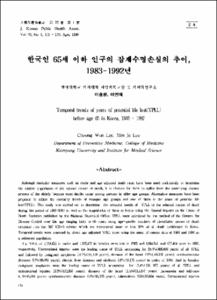KUMEL Repository
1. Journal Papers (연구논문)
1. School of Medicine (의과대학)
Dept. of Preventive Medicine (예방의학)
한국인 65세 이하 인구의 잠재수명손실의 추이, 1983-1992년
- Keimyung Author(s)
- Lee, Choong Won
- Journal Title
- 대한보건연구
- Issued Date
- 1996
- Volume
- 22
- Issue
- 1
- Abstract
- Although mortality measures such as crude and age-adjusted death rates have been used traditionally to determine the relative importance of the various causes of death, it is obvious for them to suffer from the underlying disease process of the elderly because most deaths occur among persons in older age groups. Alternative measures have been proposed to reflect the mortality trends of younger age groups and one of them is the years of potential life lost(YPLL). This study was carried out to determine the temporal trends of YPLL of the selected causes of death during the period of 1983-1992 as well as the magnitudes of them in Korea using the Annual Reports on the Cause of Death Statistics published by the National Statistical Office. YPLL were calculated by the method of the Centers for Disease Control over the age ranging birth to 65 years using age-specific numbers of classifiable causes of death tabulated into the 307 ICD-9 rubrics which are represented more or less 90% of all death certificates in Korea. Temporal trends were assessed by direct age-adjusted YPLL rates using the mean of census data of 1985 and 1990 as a reference population.
The YPLL of 1,734,456 in males and 1,022,422 in females were lost in 1983 and 1,504,841 and 657,464 were in 1992, respectively. Unintentional injuries were the leading cause of YPLL accounting for 23.4%(405,806 years) of all YPLL and followed by malignant neoplasms 10.7%(185,159 years), diseases of the heart 8.5%(148,259 years), cerebrovascular diseases 5.5%(96,050 years), chronic liver diseases and cirrhosis 5.3%(91,175 years) in males of 1983. And in females, malignant neoplasms were the leading cause of YPLL accounting for 13.4%(136,977 years) of all YPLL and unintentional injuries 11.9%(122,050 years), diseases of the heart 11.3%(115,257 years), pneumonia and influenza 8.1%(83,020 years), cerebrovascular diseases 6.5%(66,333 years), tuberculosis 5.5%(55,804 years). Unintentional injuries were accounted for 36.6%(550,040 years) of all YPLL and followed by malignant neoplasms 15.5%(232,969 years), chronic liver diseases and cirrhosis 8.2%(122,945 years), diseases of the heart 5.8%(87,018 years), cerebrovascular diseases 5.0%(75,341 years) in males of 1992. In females, unintentional injuries were the leading cause of YPLL and accounted for 23.5%(154,614 years) of all YPLL and followed by malignant neoplasms 19.9%(130,546 years), cerebrovascular diseases 7.3%(47,725 years), diseases of the heart 6.6%(43,374 years), suicide and homicide 5.1%(33,596 years). The age-adjusted YPLL rates per 1,000 persons were 90.4 for all causes in 1983 and 70.1 in 1992 resulting in 22.5 percent decrease. In females, they decreased 53.3 to 39.3 resulting in 26.3 percent change. YPLL were decreased during the period of 1983-1992 in most of the causes except congenital anomalies and prematurity in both sexes. Malignant neoplasms showed no change in males but 20.5% decrease(7.8 persons in 1983 to 6.2 persons in 1992) in females. Male-female ratios were more than 1 in most causes except pneumonia and influenza in 1983 and prematurity in 1992. These results suggest that YPLL reflect different perspectives from the conventional mortality measures and public health interventions be 7necessary to decrease the increasing proportion of unintentional injuries accounting for YPLL for all causes in both sexes.
전통적으로 사망통계는 조사망률과 연령조정 사망률을 사용하고 있으나, 이는 대부분의 사망이 고연령층에서 일어나므로 고연령자들의 원질환에 영향을 너무 많이 받는다는 단점이 있다. 그래서 젊은 연령 군의 사망추세를 반영해줄 수 있는 대안적인 측정치가 제시되고 있으며 그 중 하나가 잠재수명손실(years of potential life lost, YPLL)이다. 이 연구는 우리나라에서 12가지의 선택된 조기사망원인에 의한 잠재수명손실의 정도와 1983-1992년간에 걸친 추이를 알아보고자 하였다. 잠재수명손실은 1983년 부터 1992년 까지 경제기획원 조사통계국 및 통계청의 사망원인 통계연보에 기재된 분류가능한 자료의 기본분류(307항목)에 의한 성·연령별(5세 간격) 사망자수를 이용해서 계산하였다. 계산방법은 65세 이전에 발생하는 각 사망에 의해 손실되는 YPLL의 수로 정의되는 Centers for Disease Control(CDC)법을 사용하였다. 1983-1992년간의 시간적인 추이는 잠재수명손실률(YPLL rate)로 비교하였다. YPLL률은 1985년과 1990년의 평균 인구를 표준인구로 하여 직접법으로 계산하였다.
1983년 남자의 YPLL은 1,734,456년, 여자는 1,022,422년이었으며, 1992년 남자의 YPLL은 1,504,841년, 여자는 657,464년이었다. 12가지의 선정된 사망원인이 모든 원인에 의한 총 YPLL 중에서 차지하는 비율은 1983년 남자에서 불의의 손상이 23.4%(405,806년)로 가장 높았으며 악성 신생물 10.7%(185,159년), 심장질환 8.5%(148,259년), 뇌혈관질환 5.5%(96,050년), 만성 간질환 및 경변증 5.3%(91,175년)의 순이었으며, 여자에서 악성 신생물 13.4%(136,977년), 불의의 손상 11.9%(122,050년), 심장질환 11.3%(115,257년), 폐렴 및 인플루엔자 8.1%(83,020년), 뇌혈관 질환 6.5%(66,333년), 결핵 5.5%(55,804년)의 순이었다. 1992년 남자에서 불의의 손상 36.6%(550,040년), 악성 신생물 15.5%(232,969년), 만성 간질환 및 간경화 8.2%(122,945년), 심질환 5.8%(87,018년), 뇌혈관 질환 5.0%(75,341년)의 순이었으며, 여자에서 불의의 손상 23.5%(154,614년), 악성 신생물 19.9%(130,546년), 뇌혈관 질환 7.3%(47,725년), 심질환 6.6%(43,374년), 자살 및 타살 5.1%(33,596년)의 순으로 인구 10만명당 사망률과는 다른 양상을 나타내었다. 12가지 사인이 모든 사인에 의한 YPLL에 차지하는 비율은 1983년 남자 70.0%, 여자 64.4%이었으며 1992년에 남자 84.4%, 여자가 77.3%이었다. 1983년에 비해서 1992년의 YPLL의 변화를 보기위해 1,000명당 연령조정 YPLL율을 계산하여 비교하였다. 남자에서 모든 원인에 의한 사망이 1983년의 1,000명당 90.4년에서 1992년의 70.1년로 22.5% 감소하였으며, 여자에서는 53.3년에서 39.3년으로 26.3% 감소하였다. 남녀 모두 대부분의 사망원인에서 YPLL율이 감소를 하였으나 선천성 기형과 미숙은 오히려 증가하였다. 악성 신생물은 남자에서 변화가 없었으나 여자에서는 1983년 1,000명당 7.8명에서 1992년 6.2명으로 20.5%의 감소가 있었다. 남녀의 비는 1983년과 1992년에 유사하게 대부분의 원인에서 남자에서 더 높았으나 만성 폐색성 폐질환, 미숙, 선천성 기형, 폐렴 및 인플루엔자는 거의 차이를 나타내지 않았다. 1983년에 비해 약간의 차이를 보인 사인은 결핵과 불의의 손상으로 각각 1.77에서 2.14, 3.17에서 2.96으로 변화하였다. 이러한 결과는 YPLL이 전통적인 사망률과는 다른 관점에서 사망을 조명해주며, 불의의 손상이 우리나라에서 조기사망의 가장 중요한 원인으로서 이에 대한 대책이 시급함을 시사해준다.
- Alternative Title
- Temporal trends of years of potential life lost(YPLL)
Before age 65 in Korea, 1983-1992
- Keimyung Author(s)(Kor)
- 이충원
- Publisher
- School of Medicine
- Citation
- 이충원 and 이민재. (1996). 한국인 65세 이하 인구의 잠재수명손실의 추이, 1983-1992년. 대한보건연구, 22(1), 112–129.
- Type
- Article
- ISSN
- 1738-3897
- 파일 목록
-
-
Download
 oak-bbb-1194.pdf
기타 데이터 / 1.08 MB / Adobe PDF
oak-bbb-1194.pdf
기타 데이터 / 1.08 MB / Adobe PDF
-
Items in Repository are protected by copyright, with all rights reserved, unless otherwise indicated.